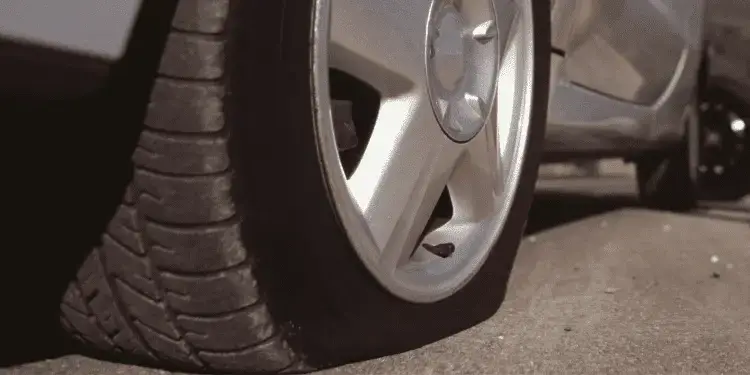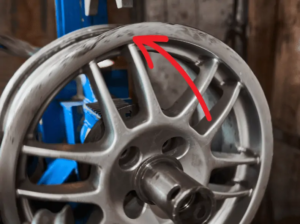So you’ve got a brand new tire on your car and thought your tire related problems were over. Alas, it wasn’t to be.
Below we will highlight the six main causes of your new tire losing air pressure.
Often, a new tire is not the cause of your air pressure problem, but it may be a symptom of another problem. This can include problems with the rim or a damaged valve.
Rim or Wheel Corrosion.
The process of aluminum corrosion on rims is a complex one. The first step of the process is oxidation, which occurs when oxygen from the air reacts with the aluminum to form aluminum oxide.
A similar event happens in steel wheels that rust rather than corrode. Rust forms on metal that become wet and reacts with oxygen in the atmosphere.
With rims, the aluminum oxide is nonconductive and non-reactive, meaning that it does not cause much damage to the rim. However, it builds up over time as more and more oxidation occurs.
Corrosion and rust happen a lot on the lip of the rim where the tire bead is connected.
This corrosion or rust can cause the rim lip to not make a tight seal with the tire bead and air escapes.
Most tire shops will tell you that your rim is corroded and may not seal a new tire or clean the rim lip and use sealant to prevent leaks from happening in the first place.
A badly corroded rim will allow air molecules to escape through it no matter how new your tire is.
Sometimes hairline cracks that a tire shop should have noticed will be big enough to allow them to escape and the pressure to drop.
Bent Rim or Wheel
Have you rubbed your rim or wheel up against a curb or been over a pothole? Both of these will cause a new tire to leak air.

If the rim is bent, the seal between it slips, and the tire bead will not be tight. A small amount of the air will escape. Sometimes it’s obvious that your rim is bent just by looking.
Other times though, if you have hit a curb or a pothole recently and the tire is leaking, check the back of the rim for damage if you can’t see any obvious damage at the front.
Related Article: Will A Cracked Rim Leak Air? [NOT ALWAYS]
Damaged Valves
A tire shop will almost always replace the valve when fitting a new tire for you. It’s extremely unusual for a car shop not to replace it, but it does happen.
Some people are under the impression that the valve is part of the tire, but it’s actually a separate part. It’s not.
A cursory glance at the valve on the tire that is losing air will tell you if it was replaced when you got your new tire fitted.
Does the rubber look old or got cracks in it? Is it faded and dirty compared to the tire?

Of course, it could be that since you had your new tire fitted, the valve has been knocked and has nothing to do with the tie shop itself, and it’s just out of bad luck.
A quick way of testing is just great soapy water on the valve area to see if any bubbles occur. If you see bubbles, then that is the valve leaking air.
Damaged Tire
You would be unlucky to buy a new tire only to get damaged immediately. Bad luck happens, though, and new tires leak because of damage.
Checking a brand-new tire for damage is the same as checking any car tire.
Start with the sidewall. Are there any signs of nicks or bulges or nails here? Don’t forget to check the inside sidewall as well. This is often forgotten.

If you can’t get underneath your car to check, rub your hand around the inside sidewall circumference to see if you can feel any metal protrusions sticking out. Next, check the tread for signs of nails and screws.
Temperature Change
A bit of a rare one, but have you changed your new tire to coincide with a change in season? For each 10-degree drop in temperature, air pressure in a tire will decrease by 1 to 2 PSI.
It is this probably universal across all you’re tires, but you may only notice this if you are concentrating on your new tire, which is a natural thing to do when you have just replaced something.
It might be worth going around and checking all the air pressures in all the tires to see if they all have this drop.
TPMS Fault
When your tire is replaced, most car shops will replace the valve at the same time. The TPMS sensor sits just below the valve, and if it wasn’t fitted securely on the valve stem, it could give a false reading of lower tire pressure.
This will require your tire to be taken off the rim to inspect.
Related Article: Tire Pressure Light Blinking But Everything Fine – [SOLVED]
It’s, therefore, best to check all the other visible outside causes before taking your car back to the tire shop to see if the TPMS sensor is defective or badly fitted.
Manufacturing Fault
It’s extremely rare for a batch of tires to leave the factory that hasn’t gone through stringent safety and quality standards. It does happen, though, and on occasions, a few thousand tires may go into the public marketplace that is faulty.
Luckily the US Tire Manufacturers Association has a database of all tires that the manufacturers have recalled. All tires sold in the US have a tire identification number.
This link will take you to a page where you can input this number and search to see if your tire is subject to a recall. Tire recall checker
If it is, the manufacturer will replace your tire free of charge as a matter of course.
Conclusion
If your brand-new site is losing air, you’re quite unfortunate. The chances are it’s not down to the tire itself, but more likely the rim or wheel related.
If the rim isn’t old, corroded, or bent, check the inner sidewall for foreign objects. Don’t forget to check the US Tire manufacturer’s site to see if your tire is subject to a recall.
Finally, the TPMS sensor may have been damaged during the new tire being mounted.


![Why Do New Tires Keep Losing Air? [SOLVED] AIR-COMPRESSOR-FLAT-TIRE](https://carzaza.com/wp-content/uploads/2023/12/AIR-COMPRESSOR-FLAT-TIRE-300x150.png)



![Can Rim Corrosion Cause A Tire Leak? [ANSWERED] flat-tire-2](https://carzaza.com/wp-content/uploads/2023/12/flat-tire-2-300x224.png)
![Car Wobbles At Low Speeds - [Troubleshooter Guide] inflating-tire-on-balancing-machine](https://carzaza.com/wp-content/uploads/2023/12/inflating-tire-on-balancing-machine-300x150.png)





